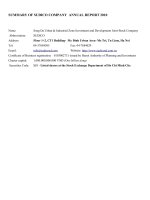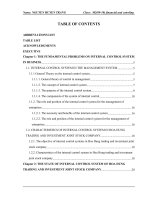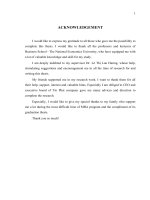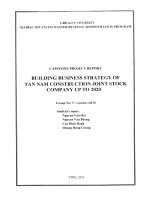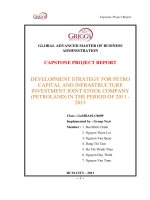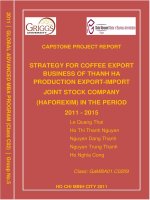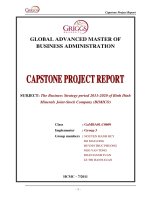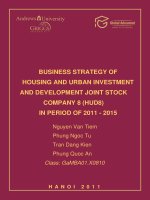2 ACCOUNTING FOR REVENUE, EXPENSES AND DETERMINING BUSINESS RESULTS AT VIET THANH TRADING TECHNOLOGY AND CONSTRUCTION JOINT STOCK COMPANY
Bạn đang xem bản rút gọn của tài liệu. Xem và tải ngay bản đầy đủ của tài liệu tại đây (4.8 MB, 91 trang )
MINISTRY OF FINANCE
ACADEMY OF FINANCE
----------
NGUYEN THI MAI LE
CQ55/21.01
GRADUATIO N THESIS
TOPIC:
ACCOUNTING FOR REVENUE, EXPENSES AND DETERMINING
BUSINESS RESULTS AT VIET THANH TRADING TECHNOLOGY AND
CONSTRUCTION JOINT STOCK COMPANY
Major
Code
Instructor
: Corporate Accounting
: 21
: M.r Nguyen Ba Linh
HA NOI – 2021
DECLARATION
I would like to assure that the graduation dissertation " Accounting
for revenue, expenses and determining business results at Viet Thanh trading
technology and construction joint stock company " is my own research project.
All the references used in this dissertation are clearly cited in the references
section. The data and results presented in the dissertation are completely
honest, I will take the responsibility and discipline of the academy if there is
any problem.
Graduation thesis author
Student
Nguyen Thi Mai Le
2
ACKNOWLEDGEMENT
First of all, i would like to express my gratefulness to all the teacher of
Academy of Finance, especially the teachers of Accounting Faculty, who have
instructed useful knowledge to me about social as well as my major. Those
knowledge are the important basis for me to orient the career path in the
future. In particular, i would like to express my gratitude to Mr Nguyen Ba
Linh for giving me the valuable guidance and suggestions during the process
of writing this dissertation. Moreover, i would like to thank the Board of
Directors, and all employees at Viet Thanh trading technology and construction
joint stock company for helping me to learn about the actual working environment
of a company and give me a chance to accumulate actual experiences about
accounting. Thanks to the accounting department, i could collect enough data and
information to accomplish my graduation dissertation successfully.
Hanoi, May 22th, 2020
Student
Nguyen Thi Mai Le
3
LIST OF ABBREVIATIONS
Acc
Account
BOD
Board of director
Cr
Credit
Dr
Debit
VND
Viet Nam Dong
COGS
Cost of goods sold
4
LIST OF DIAGRAMS
Diagram 1: Account 511 - Revenues
Diagram 2 – Revenue deduction
Diagram 3: Account 632 – Costs of goods sold
Diagram 4: Account 642 – business administration expense
Diagram 5: Account 635- Financial expenses
Diagram 6: Account 515 – Financial Income
Diagram 7: Account 711 – Other Income
Diagram 8 : Account 811 – Other expenses
Diagram 9: Account 821- Income tax expenses
Diagram 10: Account 911- Income summary
Diagram 11: Organizational Structure
Diagram 12: Accounting Organization
Diagram 13: Processing order
5
LIST OF TABLES
TABLE 2.1: GENERAL JOURNAL
TABLE 2.2: LEDGER BOOK OF ACC.5111
TABLE 2.3: LEDGER BOOK OF ACC. 131
TABLE 2.4: LEDGER BOOK OF ACC. 632
TABLE 2.5: LEDGER BOOK OF ACC. 642
TABLE 2.6: LEDGER BOOK OF ACC. 515
TABLE 2.7: LEDGER BOOK OF ACC. 635
TABLE 2.8: LEDGER BOOK OF ACC. 711
TABLE 2.9: LEDGER BOOK OF ACC. 911
TABLE 2.10: INCOME STATEMENT
6
CONTENTS
7
INTRODUCTION
1.Rationale of the study
In the light of the development of global economy, especially since Viet
Nam became an official member of WTO which has brought to Viet Nam
economy a lot of opportunities to develop. To develop and maintain the
business activities efficiently, commercial enterprieses must conduct some
measures to manage all processes from production to sale and comsumption
of goods, ensuring the maintenance and speed of capital turnover, fulfilling all
obligations to the state, enhance the living standard as well as spirit for staffs,
ensuring that profits to accumulate business expansion. Therefore, the
management of revenue and expense become an vital factor
that has a
significant impacts on business activities, and this can help the board of
director to make a business plan that reasonable in time, quantity and quality
to boost the advantages and overcome obstacles and difficulties of enterprises.
In order to have an effective plan, the role accounting for revenue,
expenses nd business results must be the first priority. Because the accounting
for revenue , expenenses and determination of business results is to
accurately, promptly and fully reflect the information on expenses ,revenue,
revenue deductions, determine the results of supply,… and providing
information to report on analytical criteria to express on financial reports.
Company owners can base on these data to control the business operation and
orient the development in the future effectively.
Recognizing the importance of revenue , expenenses accounting and
determining business results, applying theoretical knowledge learned and
researched at Acedemy Of Finance, combined with the actual experiences at
the Viet Thanh trading technology and construction joint stock company and
under the guidance of lecturers Nguyen Ba Linh and employees in the
8
accounting department at the company,i decide to chose to study the topic
"Revenue, expenses accounting and determination of business results in Viet
Thanh trading technology and construction joint stock company.
2.The aims of the study
•
The research is conducted because of these following purposes:
Systematizing and clarifying the basic theoretical issues on revenue,
•
expenses accounting and determining business results.
Surveying and presenting the current situation of the accounting work and
determine business results in Viet Thanh trading technology and construction
•
joint stock company.
Analyzing and suggesting some solutions to perfect the accounting of
revenue, expenses and determining business results inViet Thanh trading
technology and construction joint stock company.
3.Research methods.
In order to accomplish this topic, i used the following reaserch methods:
•
Document reference method: read, refer, learn the textbook compiled by
lecturers, documents in the library such as books, newspapers,
magazines, dissertations on sales accounting topics and determine
business results to find the fundament for topic. And seeking opinions
•
from instructors if the problem has not been resolved yet.
Interview method: This method is used during all the internship time.
Asking ans consulting my collegues in the company to answer my
questions and understand better about accouting and determine business
results at the company. Besides,this method helping me to accumulate
•
practical experience for myself.
Data collection and processing method: collecting raw data of the
enterprise, then all raw data are processed and selected to be accurately,
scientifically and included in the topic to give readers the most effective
information
9
•
Statistical method: Basing on the statistical data as evidence to analyze,
comparison between the reality and theoretical basis or accounting
regime and then point out the advantages and disadvantages in business
activities to find the causes and solutions for the company in general and
in particular to the revenue, expenses accounting and determining
business results.
4.The subject and scope of the study
4.1: Research objects
The thesis goes into researching the theoretical issues and current
situation of revenue, expenses accounting and determining business
results in Viet Thanh trading technology and construction joint stock
company.
4.2: Research scope
- Focusing on the actual accounting for revenue, expenses and business
results in terms of financial accounting at Viet Thanh trading technology
and construction joint stock company.
- Regarding specific address: research is performed in accounting
department in Viet Thanh trading technology and construction joint stock
company.
- Regarding time: studying theoretical issues and surveying actual
situation in Viet Thanh trading technology and construction joint stock
company.
5. Structure of the thesis
The gratuation dissertation consists of 3 chapters:
Chapter 1: General theory of accounting for revenue, expenses and
business results in enterprises
10
Chapter 2: Practical situation of accounting for revenue, expenses and
determine business results at Viet Thanh trading technology and construction
joint stock company
Chapter 3: Solutions to improve accounting for revenue, expenses and
business results at Viet Thanh trading technology and construction joint stock
company
11
CHAPTER 1: GENERAL THEORY OF ACCOUNTING FOR
REVENUE, EXPENSES AND BUSINESS RESULTS IN ENTERPRISES
1.1. General theory of revenue, expenses and determination of business
results in enterprises
1.1.1. Importance of accounting for revenue and business result in
Enterprises.
In the light of proliferation of global economy, each enterprise have to
choose an appropriate business plan to meet the diverse requireements of
market to enhance business performance. The accounting for revenue,
expenses and business results is necessary condition for company to maintain
and develop business activities.
The duties of The accounting for revenue, expenses and business results
is that calculate and aggregate costs directly or indirectly related to the
business process as well as accurately determining the actual revenue occur in
enterprises, and these data are basis to determine the results of business
activities. Accurate determination of business results contributes to provide
useful information and help businesses to research and build a reasonable
costs for each expense and a suitable price for each product and service.
1.1.2. The basis of revenue
1.1.2.1. Definition of revenue
Revenues and other incomes are increases in economic benefits as a
result of ordinary activities and other events of the enterprise during the
accounting period in the form of inflows or enhancements of assets or
decreases of liabilities that result in increases in equity, other than those
relating to contributions from equity participants.
1.1.2.2. Classification of revenue
12
•
Classification according to business activities of the enterprise:
- Sales of goods and services: the full amount of the business revenue
are received from transactions such as selling products and offering
services to customers
- Revenue from financial activities :
+Interest: deposit interest, loan interest, sales interest on deferred
payment, installment payment
+ Profits from selling, transferring financial asset or investing on joint
ventures, investing on subsidiaries
+ Dividends and profits distributed
+Interest difference due to foreign currency trading, foreign currency
exchange rate difference interest;
+Payment discount enjoyed by purchase of materials, goods, services,
fixed assets;
+ Other income related to financial activities.
- Other income:
+ Income from sale or liquidation of fixed assets;
+ Income from liquidation of fixed assets, sale of fixed assets;
+ Collecting customer fines for breaching the contract;
+Collected insurance indemnity;
+Collection of bad debts.
+Incomes from gifts and gifts in cash and in kind from organizations
•
and individuals donated to businesses;
+ Other revenues.
Classification according to the method of payment for goods includes:
+ Cash on hand,
+ Revenue on deferred payment,
+ Revenue received in advance.
1.1.2.3. Revenue recognition
-Sale of goods:
Revenue is recognised when all the following conditions have been
satisfied:
13
(a) The entity has transferred the significant risks and rewards of
ownership of the goods to the buyer.
(b) The entity does not retain control over the goods or managerial
involvement with them to the degree usually associated with ownership.
(c) The amount of revenue can be measured reliably.
(d) It is probable that the economic benefits associated with the
transaction will flow to the entity.
(e) The costs incurred or to be incurred by the seller in respect of the
transaction can be measured reliably.
- Provision of services:
The outcome of a transaction can be estimated reliably when all the
following conditions are satisfied:
(a) The amount of revenue can be measured reliably.
(b) It is probable that the economic benefits associated with the
transaction will flow to the seller.
(c) The stage of completion of the transaction at the end of the reporting
period can be measured reliably.
(d) The costs incurred to date for the transaction and the costs to complete
the transaction can be measured reliably.
In cases where a service provision transaction is conducted in many
accounting periods, the determination of the turnover of a service in each
period is usually made according to the completion rate method. By this
method, the revenue recognized in the accounting period is determined by the
proportion of the completed work.
The completed work is determined by one of the following three
methods, depending on the nature of the service:
(a) Assess completed work;
14
(b) Comparing the percentage (%) between the completed workload and
the total workload to be completed;
(c) The ratio (%) of expenses incurred to the total estimated cost of
completing the entire service delivery transaction.
The completed work does not depend on recurring payments or advances
by customers.
- Revenue from interests, royalties, dividends and shared profits of an
enterprise is recognized when both the following conditions are satisfied:
(a) Be able to obtain economic benefits from the transaction;
(b) The revenue is determined reliably.
1.1.2.4. Revenue deductions
•
Trade discount is the amount of money that enterprise credited or paid
to customers who bought goods and services in large volume in
accordance with the agreement that the seller will give trade discount to
the buyer.
•
Sales returns is the amount of goods sold which have subsequently
been returned due to the following reasons: breaching the commitment
or the economic contract, or in a wrong quantity, quality or
specifications.
•
Sales allowance is a reduction made when the goods are not the same
specification as those mentioned in the economic contract.
•
Taxes: VAT in direct method, export duty
1.1.3. The basics of expenses
1.1.3.1. Definition of expenses
Expenses are decreases in economic benefits during the accounting period in
the form of outflows or depletions of assets or incurrences of liabilities that
15
result in decreases in equity, other than those relating to distributions to equity
participants
1.1.3.2. Classification of expenses
Classification of costs can be made on the basis of:
•
Business function
•
Assignment to a cost object
-
Direct costs of a cost object are those that are related to a given
cost object (product, department, etc.) and that can be traced to it
-
in an economically feasible way.
Indirect costs are related to the particular cost object but cannot
be traced to it in an economically feasible way.
•
Behaviour pattern in relation to changes in the level of a cost driver
-
Variable costs change in total in proportion to changes in the related
-
level of total activity or volume.
Fixed costs do not change in total for a given time period despite wide
changes in the related level of total activity or volume.
•
Assets or expenses
-
Capitalised costs are all costs of a product that are regarded as an
asset when they are incurred and then become cost of goods sold
-
when the product is sold.
Revenue costs are all costs in the Profit and loss account other
than cost of goods sold.
1.1.4. The basics of business results
1.1.4.1. Definition of business results
Determining business results of business activities is the important work
to be done at the end of each accounting period. The financial statements must
be made and sent to the functional agencies on a monthly basis, so an
accountant usually determines the business results of the company's business
16
activities each month. Business results of company are the business results of
an company expressed in products or services, bringing consumer benefits, in
line with economic benefits and civilization qualifications of the company,
social consumption and consumer acceptance. In other words, business results
are the results obtained from the process of selling products to consumers.
Determining accurate business results is the basis for proper profit
distribution. And a final overall review of the business process of the
business. Therefore, business results should be determined accurately and
honestly.
1.2. Accounting for revenue, expenses and business results in enterprises
1.2.1 The accounting principles governing accounting for revenue,
expenses and business results in enterprises
( em xin phép bổ sung sau ạ)
1.2.2. Accounting for Revenue
1.2.2.1. Accounting for revenue from sales of goods and services
Accounting vouchers:
• VAT invoice
• Sales invoice
• Payment table for consignment, agent
• Delivery note
• List of retail goods and services
• Payment vouchers (receipts, transfer checks, payment checks,
collection orders, Bank Credit Notes, Bank statements, ...)
- For enterprises subject to VAT payment by the deduction method, when
selling goods and services, use "VAT Invoice" issued by the Ministry of
Finance, self-printed VAT invoice, VAT invoice order printed (except for the
case where the vouchers indicate the VAT-inclusive payment price).
- For enterprises subject to VAT payment under the direct method, when
selling goods or services, use "Sale Invoice".
17
Accounts used:
Account 511 “ Sales”
Content:
This account is used to record sales of goods and services of enterprise
in an accounting period, including sales of goods, products and services
provided to parent companies and subsidiaries in the same group in the
accounting period.
Account 511 reflects the turnover of production and business
activities from the following transactions and operations:
+ Sales: Selling items manufactured by company, selling of goods
purchased real estates invested
+ Service provision: carrying out services agreed in contract for one or
more accounting periods, such as providing transportation or travel
services, leasing of Fixed Assets in ways of operating lease, turnovers
from construction contract...
+ Other revenues.
Structure:
Acc 511
- Payable indirect taxes (VAT, excise, export, - Revenues from sales of products, goods,
environmental protection);
real estates invested and service provision
- Turnover from returned goods transferred
of enterprises performed in accounting
at the end of period;
period.
- Trade discounts transferred at the end of
- The revenue subsidized
period;
grants, surcharges that the company
- Transfer of net turnover to acc 911.
gains.
Account 5Acc 511does not have ending balance and it comprises 5
secondaries
18
Accounts used:
•
Acct 5111: Turnover from sales.
Acc 5112: Turnovers from finished goods.
Acc5113: Turnovers from service provision.
Acc 5114 "Revenue grants and subsidies"
Acc 5118: Other turnovers.
Common transactions:
Diagram 1: Account 511 - Revenues
(1)
Revenue from sales and rendering service
(1b) Payable taxes when selling goods and providing services
2
Transfer revenue to account 911
3
Revenue deduction
Accounting Principles
- For products, goods and services are subjects to special consumption tax or
export tax, sales from selling goods and providing services are the total
payment price (including special consumption tax or export tax).
19
- For the goods received by agents, consigned by the method of selling at the
right price, sales from selling goods and providing services will receive the
sales commission that enterprises enjoy.
- In case of insurance by the mode of deferred or installment payment, the
enterprise shall record the revenue from the selling price immediately and
record in the financial income the interest calculated on the payable but
deferred payment in accordance with the time when the recognition of
revenue is confirmed.
1.2.2.2. Accounting for revenue deductions
Definition
Sale deductions are amounts to be deducted from sales of goods and
services provided in the period, including: Trade discounts, sales allowance
and sales returned.
•
Trade discount is the amount of money that enterprise credited or paid
to customers who bought goods and services in large volume in
accordance with the agreement that the seller will give trade discount to
the buyer.
•
Sales returns is the amount of goods sold which have subsequently
been returned due to the following reasons: breaching the commitment
or the economic contract, or in a wrong quantity, quality or
specifications.
•
Sales allowance is a reduction made when the goods are not the same
specification as those mentioned in the economic contract.
•
Taxes: VAT in direct method, export duty
Accounting vourchers:
•
Sales discounts:
- VAT invoice or sales invoice
20
- Economic contracts
•
Sales allowances:
- Minutes of sales allowances
- Sales allowances invoice
- Accounting voucher of sales allowances
•
Sales returns:
- Minutes of goods return
- VAT invoice or sales invoice
- Goods receipt
- Accounting voucher of sales returns
Accounts used
• Acc. 521 – Sale deductions:
• Acc. 5211 Trade/Sales discounts
• Acc. 5212 – Sales returns
• Acc. 5213 – Sales allowances
• Acc. 333 – Tax and statutory obligations
Common transactions:
Diagram 2: Accounting entry for revenue deductions
21
22
Accounting principles
The sales deduction must be recorded separately: in which the trade
discounts, sales discount is defined as follows:
•
Enterprises must have management regulations and disclose publicly
trade discounts, sales discounts.
•
The trade discounts or sales discounts of goods sold in the period
ensure the profitability for the company.
•
Must be specified in the contract and sales invoices.
1.2.2.3. Accounting for financial income
•
Definition:
Financial incomes are all incomes gained in relation to financial
activities of the company.
23
•
−
Revenue from financial activities includes:
Interests: loan interests, deposit interests, installment interests, deferred
payment interests, interests on bonds, treasury bills, payment discounts
−
−
−
due to purchases of goods/services, etc.;
Financial investment : Dividend, distributed profit, Profit from the
investment transfer
Payment discount received
Foreign exchange differences:
+ Profit from exchange rate difference (business activities +
+
construction process)
Profit from revaluating closing balance of foreign currency
+
monetary items (business activities + construction process)
Allocate profit from exchange rate difference (construction before
operation)
Account used:
“Account 515: Financial incomes”
• Content: to record revenues from interests, copyrights, dividends,
distributed income, and other income from financial activities of
•
enterprises.
Structure:
Acc 515
- The payable VAT amount calculated by the - Revenue from financial
direct method (if any);
arising in the period.
- Transfer of net financial income to Acc 911.
Account 515 has no closing balance.
Accounting entries
Diagram 3: Accounting entry for financial incomes
24
activities
1.2.4. Accounting for other income
Definition:
Other incomes are incomes that is not a turnover of the business.
These are the incomes generated from activities other than the common
business activities of the enterprise, the specific contents include:
25
